 |
|
|
 |
Above 42 MV/m for a single cell cavity electropolished at Saclay
Last January, engineers from the DAPNIA laboratory in Saclay France qualified a new electropolishing facility for single cell cavities. Their first electropolished cavity reaches a promising result, above 42 MV/m (megavolts per metre) of accelerating gradient. It allows them to join the global R&D effort on these cavity treatments.
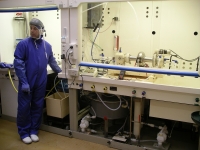
The newly qualified electropolishing facility at Saclay. |
Before they are used to accelerate electrons and positrons, cavities have to be meticulously polished and cleared. All these treatments improve the accelerating gradient a cavity can achieve. The cavity surface cleaning and smoothing chain includes mechanical treatments, buffered chemical polishing, electropolishing, high pressure rinsing and baking. At Saclay, France, the DAPNIA laboratory has been working on RF cavities for about 15 years, within the TESLA collaboration. They already had chemical and baking facilities, a class 100 clean room, and vertical and horizontal RF test stands. In October, they went one step further with the end of the construction of new installation, a new electropolishing facility for single cell cavities. For safety reasons, it took them time to be ready for tests, as manipulating such dangerous acid like hydrofluoric acid requires passing very strict safety checks.
Read more...
-- Perrine Royole-Degieux |
 |
|
|
 |
|
 |
Cornell University Moves Forward on Vertical Electropolishing
Recent results from Cornell University demonstrated
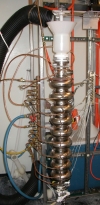
The vertical electropolishing
set up at Cornell.
|
that a new method of electropolishing superconducting cavities may hold promise for the International Linear Collider. For the past two years, Cornell scientists have been developing an electropolishing method that treats cavities vertically as opposed to the traditional horizontal orientation developed by KEK. Cornell recently applied this new vertical method to a nine-cell ILC cavity for the first time and achieved positive results. “This is the first step to show the viability of the new method,” says Cornell physicist Hasan Padamsee.
Read more...
-- Elizabeth Clements |
 |
|
|
 |
From Interactions.org
13 March 2007
New Form of Matter-antimatter Transformation Observed for the First Time
For the first time, scientists of the BaBar experiment at the Department of Energy's Stanford Linear Accelerator Center (SLAC) have observed the transition of one type of particle, the neutral D-meson, into its antimatter particle.
Read more... |
|
From Interactions.org
12 March 2007
Jonathan Dorfan to step down as SLAC director
Jonathan Dorfan, who has served as the director of the Stanford Linear Accelerator Center (SLAC) for nearly eight years, has announced he will step down this fall.
Read more... |
|
From The New York Times
11 March 2007
Out There
(subscription required)
Dark energy, an invisible, undetectable force that seems to break all the rules of physics, may be about to redefine the universe.
Read more... |
|
From Fermilab Today
9 March 2007
Science, design, costing for the ILC--and Fermilab's role
Employees gathered Wednesday in the Auditorium to learn more about the ILC and Fermilab's role in it.
Read more... |
|
From Economist.com
8 March 2007
Onwards and upwards
Plans to build ever-grander particle-smashers collide with reality.
Read more... |
|
|
 |
Salute to Jonathan!
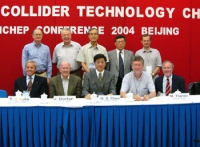
Jonathan Dorfan (second from left, front row) presiding over the ICFA press conference announcing the selection of superconducting RF technology for the ILC. |
Earlier this week, Jonathan Dorfan announced in SLAC Today that he is stepping down this fall as SLAC Director after eight very successful years. Jonathan has not only been serving as SLAC's leader during this period, but he has also been a driving force in the world high energy physics community over the past decade. Jonathan's contributions to the field are many, but they are epitomised by the leadership he provided to the International Committee for Future Accelerators (ICFA), which he chaired from 2003-2005. As the world of high energy physics had become more and more international, Jonathan strongly supported the many initiatives that have placed high energy physics at the very front of international collaboration in physics, and in fact in science.
Read more...
-- Barry Barish
Director's Corner Archive |
 |
|
|
 |
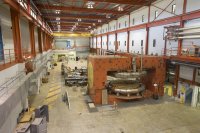
Before
|
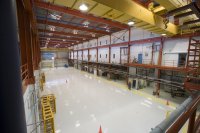
After
|
A sparkling new ILC Test Facility in Fermilab's New Muon Lab awaits
cryomodules, which will be tested here. (Credit: Fermilab photos)
|
|
ILC-Related Preprints
hep-ph/0703121
12 Mar 2007
Measurements of Metastable Staus at Linear Colliders
hep-ph/0703099
9 Mar 2007
Extra Neutral Gauge Boson from Two Versions of the 3-3-1 Model in Future Linear Colliders |
|

